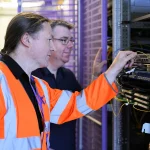Cityfibre Finds Support for Fibre Broadband Adverts Legal Challenge
A Censuswide survey of 3,422 home broadband ISP users has found support for Cityfibre’s legal challenge of the current UK advertising rules, which they say “misleadingly” allows so-called hybrid fibre ISPs to promote their services as being “fibre optic” despite using slower metallic cables (e.g. copper).
Pure fibre optic ISPs generally deliver significantly faster speeds (i.e. they can handle multi-Gigabit or faster speeds) and are more reliable, while hybrid fibre (aka – part fibre) services use a mix of metallic and optical fibre cables, which tends to make them both a lot slower and less reliable.
Back in 2008 the Advertising Standards Authority (ASA) ruled that it was happy for hybrid fibre services, such as those based off Openreach’s (BT) Fibre-to-the-Cabinet (FTTC / G.fast) technologies or Virgin Media’s EuroDOCSIS using Hybrid Fibre Coax platform, to use “fibre” in their advertising because the optical fibre cable still accounted for a big chunk of their networks.
Advertisement
In the past few cared about this because Gigabit capable Fibre-to-the-Premise (FTTP/H) style networks were in the minority but all that is now beginning to change, particularly with the government’s recent push for nationwide coverage by 2033 (here). Last year the ASA finally agreed to review the situation but in the end they only recommended minor tweaks (here).
Naturally Cityfibre, which has built a lot of “full fibre” (FTTP) networks across the UK, disagreed and eventually managed to win a Judicial Review (here). In order to support that battle the company has today published the results of a new Censuswide survey (conducted during early July 2018), which it commissioned. Obviously there’s an element of vested interest here but the results are worth reflecting.
Summary of the Key Results
* The majority (86%) thought the type of cable connecting them to the internet made a difference to the speed they received, but 65% didn’t think their current connection relied on copper cables or hybrid copper-fibre, even though this is the case for most consumers.
* Some 24% think they already have fibre cables running all the way to their home (FTTP/H), despite this only being available to around 4% of UK properties.
* Close to half (45%) believe that services currently advertised as “fibre” deliver this type of connectivity as standard, highlighting how confusing the status quo has made broadband for consumers.
* Once the difference between hybrid copper-fibre connections and full fibre was explained, two thirds thought the advertising rules should be changed so that hybrid services could no longer be called “fibre”.
* While just under two thirds (65%) said their broadband provider had described their connection as “fibre”, only 17% thought this connection would include copper cables.
ISPreview.co.uk also ran a snap poll of 200+ respondents when the ASA announced their decision last year and at the time 83% agreed that only FTTH/P ISPs should be able to use “fibre broadband” in their advertising. Cityfibre’s current action has also received wide support from other full fibre ISPs, such as Gigaclear and Vodafone etc.
Cityfibre also said they’d written to the CEOs of all the major broadband providers (BT, Virgin Media, TalkTalk, Sky Broadband, Vodafone, EE and the Post Office) asking them to change the way they advertise broadband to customers now, rather than wait for the Judicial Review of the ASA’s decision to conclude. We suspect they’ll wait.
Advertisement
Greg Mesch, CEO of CityFibre, said:
“Years of misleading advertising of broadband speeds and technologies have left people totally confused about what they are paying for, undermining trust in the industry. It is time to put the customer at the heart of the full fibre rollout and ditch dishonest descriptions once and for all.
We are calling on all broadband providers to stop using the word “fibre” unless it is describing a full fibre connection. Rather than waiting for the backward-looking ASA to be forced to act, the industry should stand as one and pave the way for a new generation of connected homes, businesses, towns and cities across the UK.”
The challenge, win or lose, will remain the difficult task of trying to unpick something that has long since become established in the consumer subconscious, where the meaning of “fibre” has for many years now become diluted by slower hybrid (part) fibre services.
Meanwhile the ASA are about to put their counter argument to the court, although it’s not yet clear how long it will take the court to reach a conclusion or what they might recommend. Either way it would certainly be nice if this question could be cleared up, once and for all.
Mark is a professional technology writer, IT consultant and computer engineer from Dorset (England), he also founded ISPreview in 1999 and enjoys analysing the latest telecoms and broadband developments. Find me on X (Twitter), Mastodon, Facebook, BlueSky, Threads.net and Linkedin.
« Local Policy Changes Needed to Boost 5G and Full Fibre in UK Cities

















































Comments are closed